In search of the best remedy
In this article, I’ll show you how I met Quest Netvault Backup. About Netvault Backup, when this software was still owned by Dell, I had already heard a lot of positive reviews, but I hadn’t yet to “touch” it with my hands.
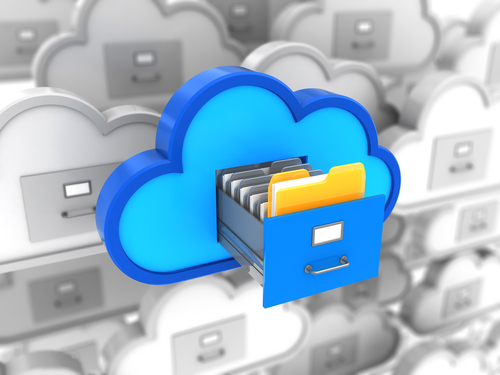
Quest Software, also known as Quest, is a California-based software company with 53 offices in 24 countries. It was founded in 1987. The company is known for its software used by professionals in the field of databases, in cloud management, in information security, for data analysis, for backup and recovery. Quest Software was acquired by Dell in 2012. By November 1, 2016, the sale was completed and the company restarted as Quest Software.
Tightly get to know Quest Netvault not so long ago. In one of the projects, the Customer asked to find an inexpensive and optimal solution for protecting his infrastructure. The customer was considering various backup software, one of the solutions was Quest Netvault Backup. Based on the test results, given the parameters important to the Customer (some of which are given at the end of the article), Quest Netvault Backup was selected.
In addition to the basic requirements, the Customer wanted the software to be installed on servers running Linux. Such requirements are not implemented by every backup software, but Quest Netvault Backup can do this.
The task set by the Customer was to design a system that provides data backup in the amount of 62 TB. This data was contained in such application systems as SAP, Microsoft SQL, PostgreSQL, MariaDB, Microsoft Exchange, Microsoft SharePoint, etc. These application systems ran on physical and virtual servers running operating systems of the Microsoft Windows Server, Linux, and FreeBSD family. The virtual environment was built on top of the VMware vSphere virtualization platform. Infrastructure was located on one site.
In general, the Customer’s infrastructure is shown in Figure 1.1.
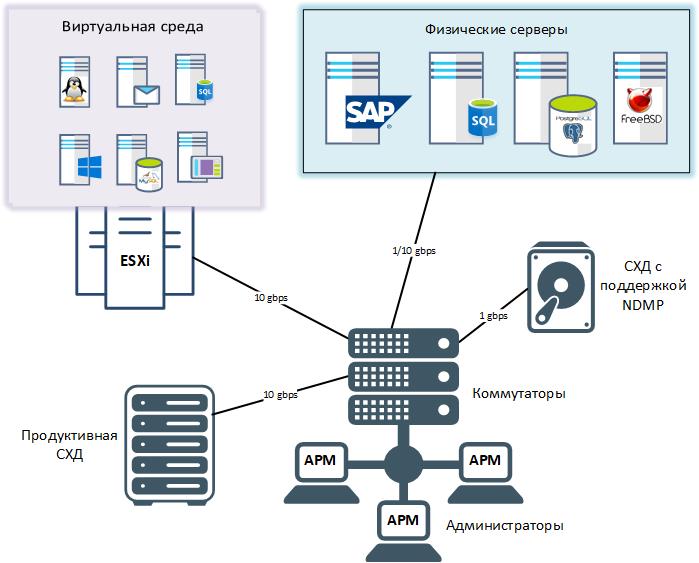
Figure 1.1 - Customer Infrastructure
The analysis examined the capabilities of Quest Netvault Backup applicable to the Customer’s infrastructure, namely: in terms of performing backup, recovery, management and monitoring of data. Typical functionality and principles of operation practically do not differ from the software of other vendors. Therefore, I want to dwell on the features of Quest Netvault Backup, which distinguish it from other backup tools.
Installation The
size of the Quest Netvalt Backup distribution is only 254 megabytes, which allows you to quickly deploy it.
Plugins for supported platforms and tasks are downloaded separately, but this has a positive effect on the target state of the system, which will only have the functionality that is necessary to protect a certain infrastructure and will not be overloaded with unnecessary capabilities.
Management
Netvault administration is done through the WebUI web shell. Login is by name and password.
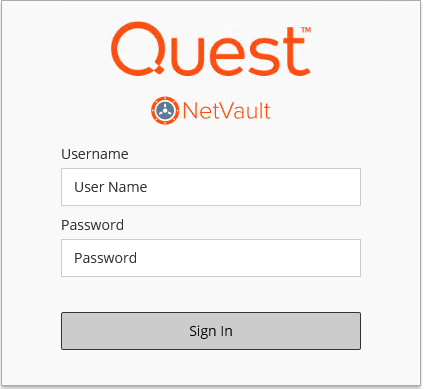
Figure 1.2 - Login window to the management console
Connection to the web console is carried out from any computer on the network using a browser.
WebUI uses a simple and friendly interface, administration does not cause any problems, the management logic is accessible and understandable, if questions arise, then the vendor’s website contains detailed product documentation .
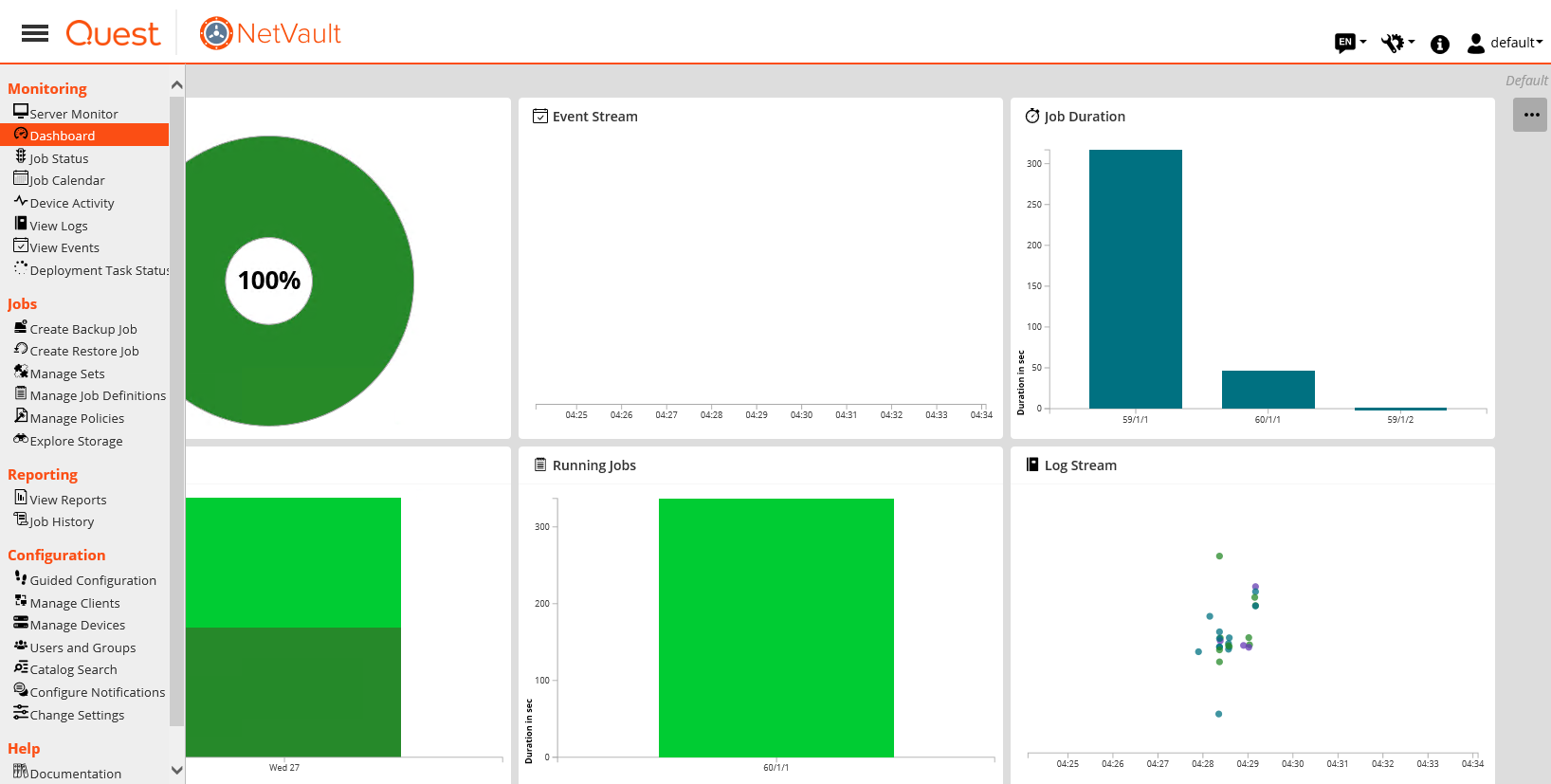
Figure 1.3 - WebUI
WebUI is designed to manage and control Quest Netvault Backup and allows you to perform the following tasks:

Figure 1.4 - Storage device management

Figure 1.5 - Monitoring device activity
Storage devices
Quest Netvault easily implements the 3-2-1 storage rule, as it can also work with devices for online backup storage (disk storage systems), as well as with devices for long-term storage (deduplicating devices, physical tape libraries, autoloaders , virtual tape libraries (VTL) and shared virtual tape libraries (SVTL)). Alienable backups can be stored in the cloud, on a remote site, or on alienable media (for example, tape drive).
When working with deduplicating devices, specialized RDA and DD Boost protocols are supported. Using these protocols:
Clients
Quest Netvault Backup supports more than three dozen platforms and applications. You can get acquainted with the list in more detail on the vendor's website using the link (Figure 1.6). Checking the compatibility of versions of protected systems with Quest Netvault Backup is carried out according to the official document "Quest Netvault Backup Compatibility Guide" located at the link .
Supporting so many systems allows you to design solutions for complex enterprise-level infrastructures. Clients are distributed in the form of plugins (similar to other vendors - agents), which are installed on servers. As a result, data is protected using a single system with a single management point.
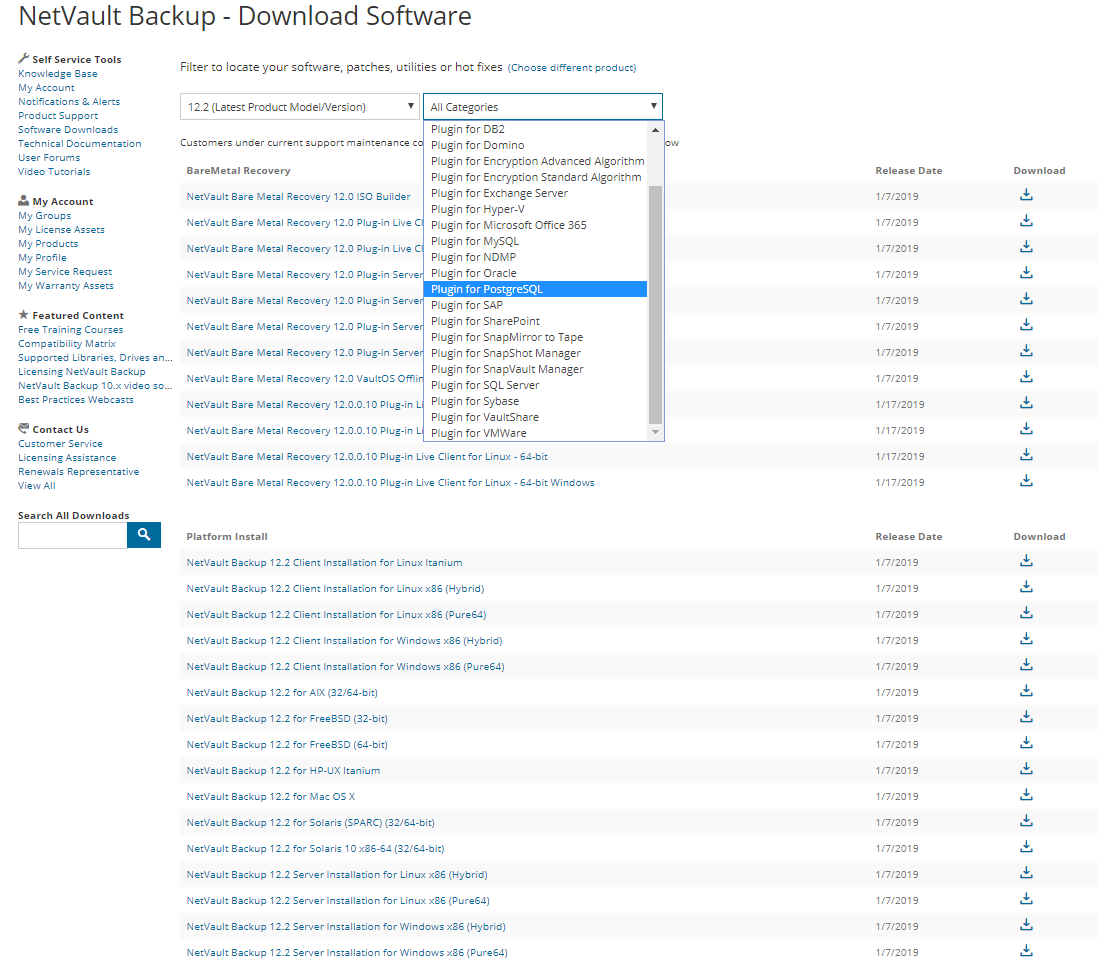
Figure 1.6 - List of plugins
After downloading the plugins for these platforms, we place them in a shared folder that we connect to Netvault and then remotely install plugins on the protected servers.
One more advantage, I consider the clarity of the choice of objects to be backed up. For example, in the figure below we select as the objects the state of the server system and the logical drive c: \.

And this figure shows the selection of hard disk partitions.

In addition to plug-ins for platforms running on separate servers, Quest Netvault Backup also has plug-in versions that support various cluster systems. In this case, the cluster nodes are grouped into a virtual client, on which the plugin with cluster support is installed. Cluster nodes will be backed up and restored already through this virtual client. The table below shows the cluster versions of the plugins.
Table 1.2 Plug-ins with support for cluster systems
The result of the project was a backup system deployed by the Customer based on Quest Netvault Backup software with the architecture shown in Figure 1.7.
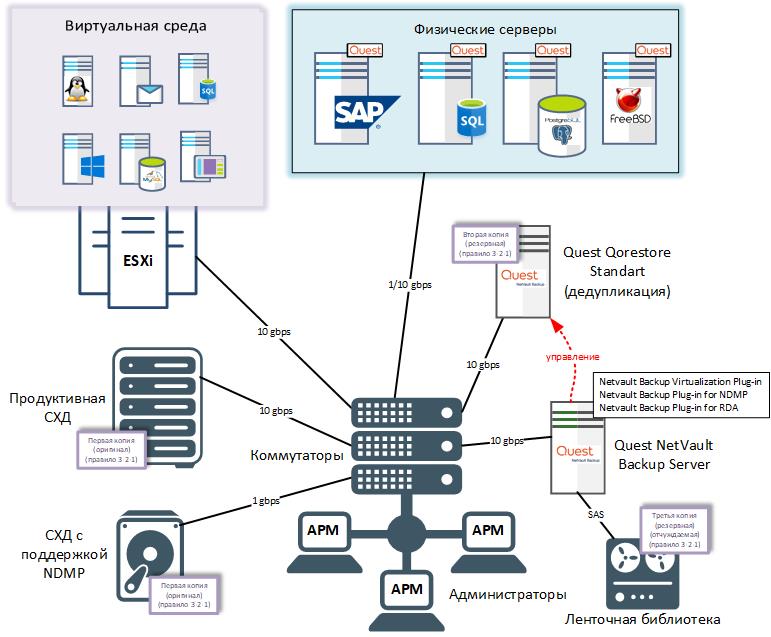
Figure 1.7 - Target system status
All Netvault Backup components were deployed on a physical server with the following characteristics:
Online backups were stored on Quest Qorestor Standard (back end 150TB). Work with Qorestor was carried out according to the RDA protocol. The deduplication coefficient on Qorestor at the end of the trial operation of the system was 14.7 to 1.
For long-term storage, a tape library with four LTO-7 standard drives was used. The tape library connected to the backup server via SAS. Periodically, the cartridges were disposed of and moved for storage to one of the remote branches.
All necessary plugins were downloaded and placed on a network folder for remote installation. The deployment and configuration time for this system was nine days.
According to the results of the project, I can say that Quest Netvault Backup was able to implement all the requirements of the Customer and this solution is one of the tools for building a backup system for both small companies and Enterprise level Customers.
Most of the parameters that were used to evaluate the solutions are shown in the comparison table.
Table 1.3 - Comparison table
Authors:
Fedotov Mikhail - Backup Systems Architect

Quest Software, also known as Quest, is a California-based software company with 53 offices in 24 countries. It was founded in 1987. The company is known for its software used by professionals in the field of databases, in cloud management, in information security, for data analysis, for backup and recovery. Quest Software was acquired by Dell in 2012. By November 1, 2016, the sale was completed and the company restarted as Quest Software.
Tightly get to know Quest Netvault not so long ago. In one of the projects, the Customer asked to find an inexpensive and optimal solution for protecting his infrastructure. The customer was considering various backup software, one of the solutions was Quest Netvault Backup. Based on the test results, given the parameters important to the Customer (some of which are given at the end of the article), Quest Netvault Backup was selected.
In addition to the basic requirements, the Customer wanted the software to be installed on servers running Linux. Such requirements are not implemented by every backup software, but Quest Netvault Backup can do this.
Baseline and requirements
The task set by the Customer was to design a system that provides data backup in the amount of 62 TB. This data was contained in such application systems as SAP, Microsoft SQL, PostgreSQL, MariaDB, Microsoft Exchange, Microsoft SharePoint, etc. These application systems ran on physical and virtual servers running operating systems of the Microsoft Windows Server, Linux, and FreeBSD family. The virtual environment was built on top of the VMware vSphere virtualization platform. Infrastructure was located on one site.
In general, the Customer’s infrastructure is shown in Figure 1.1.

Figure 1.1 - Customer Infrastructure
The analysis examined the capabilities of Quest Netvault Backup applicable to the Customer’s infrastructure, namely: in terms of performing backup, recovery, management and monitoring of data. Typical functionality and principles of operation practically do not differ from the software of other vendors. Therefore, I want to dwell on the features of Quest Netvault Backup, which distinguish it from other backup tools.
Interesting features
Installation The
size of the Quest Netvalt Backup distribution is only 254 megabytes, which allows you to quickly deploy it.
Plugins for supported platforms and tasks are downloaded separately, but this has a positive effect on the target state of the system, which will only have the functionality that is necessary to protect a certain infrastructure and will not be overloaded with unnecessary capabilities.
Management
Netvault administration is done through the WebUI web shell. Login is by name and password.

Figure 1.2 - Login window to the management console
Connection to the web console is carried out from any computer on the network using a browser.
WebUI uses a simple and friendly interface, administration does not cause any problems, the management logic is accessible and understandable, if questions arise, then the vendor’s website contains detailed product documentation .

Figure 1.3 - WebUI
WebUI is designed to manage and control Quest Netvault Backup and allows you to perform the following tasks:
- tuning performance, security and other parameters;
- Manage clients, storage devices, and media

Figure 1.4 - Storage device management
- performing backup and recovery;
- monitoring tasks, device activity and event logs;

Figure 1.5 - Monitoring device activity
- notification settings;
- creating and viewing reports.
Storage devices
Quest Netvault easily implements the 3-2-1 storage rule, as it can also work with devices for online backup storage (disk storage systems), as well as with devices for long-term storage (deduplicating devices, physical tape libraries, autoloaders , virtual tape libraries (VTL) and shared virtual tape libraries (SVTL)). Alienable backups can be stored in the cloud, on a remote site, or on alienable media (for example, tape drive).
When working with deduplicating devices, specialized RDA and DD Boost protocols are supported. Using these protocols:
- reduces the load on the network and improves the performance of backup tasks, since the data is deduplicated on the client and only the necessary blocks are transferred. For example, working in conjunction with Quest Qorestor via the RDA protocol can achieve performance up to 20 terabytes per hour and compression of 20 to 1;
- protects backups from ransomware viruses. Even if the backup server itself is infected and encrypted, the backups will remain untouched. link .
Clients
Quest Netvault Backup supports more than three dozen platforms and applications. You can get acquainted with the list in more detail on the vendor's website using the link (Figure 1.6). Checking the compatibility of versions of protected systems with Quest Netvault Backup is carried out according to the official document "Quest Netvault Backup Compatibility Guide" located at the link .
Supporting so many systems allows you to design solutions for complex enterprise-level infrastructures. Clients are distributed in the form of plugins (similar to other vendors - agents), which are installed on servers. As a result, data is protected using a single system with a single management point.

Figure 1.6 - List of plugins
After downloading the plugins for these platforms, we place them in a shared folder that we connect to Netvault and then remotely install plugins on the protected servers.
One more advantage, I consider the clarity of the choice of objects to be backed up. For example, in the figure below we select as the objects the state of the server system and the logical drive c: \.

And this figure shows the selection of hard disk partitions.

In addition to plug-ins for platforms running on separate servers, Quest Netvault Backup also has plug-in versions that support various cluster systems. In this case, the cluster nodes are grouped into a virtual client, on which the plugin with cluster support is installed. Cluster nodes will be backed up and restored already through this virtual client. The table below shows the cluster versions of the plugins.
Table 1.2 Plug-ins with support for cluster systems
| Plugin | Description |
|---|---|
| Plug-in for file system | This plugin is used when setting up file system data backup on the following platforms: - Windows Server clusters; - Linux clusters; - Sun clusters (Solaris SPARC) |
| Plug-in for exchange | This plugin is used when setting up a backup of a Microsoft Exchange server using Database Availability Group (DAG) technology |
| Plug-in for hyper-v | This plugin is used when setting up backup of a failover cluster of Hyper-V |
| Plug-in for oracle | This plugin is used when setting up an Oracle Database backup on Oracle's Real Application Clusters (RAC) |
| Plug-in for sql server | This plugin is used when setting up backup of a Microsoft SQL Server failover cluster. |
| Plug-in for mysql | This plugin is used when setting up MySQL Server backup in a failover cluster. |
Implementation Result
The result of the project was a backup system deployed by the Customer based on Quest Netvault Backup software with the architecture shown in Figure 1.7.

Figure 1.7 - Target system status
All Netvault Backup components were deployed on a physical server with the following characteristics:
- two processors with ten cores each;
- 64 GB of RAM;
- two SAS 300GB 10K hard drives (RAID1)
- four SAS 600GB 15K hard drives (RAID10);
- HBA with two external SAS ports;
- two 10 gbps ports;
- OS CentOS.
Online backups were stored on Quest Qorestor Standard (back end 150TB). Work with Qorestor was carried out according to the RDA protocol. The deduplication coefficient on Qorestor at the end of the trial operation of the system was 14.7 to 1.
For long-term storage, a tape library with four LTO-7 standard drives was used. The tape library connected to the backup server via SAS. Periodically, the cartridges were disposed of and moved for storage to one of the remote branches.
All necessary plugins were downloaded and placed on a network folder for remote installation. The deployment and configuration time for this system was nine days.
conclusions
According to the results of the project, I can say that Quest Netvault Backup was able to implement all the requirements of the Customer and this solution is one of the tools for building a backup system for both small companies and Enterprise level Customers.
Most of the parameters that were used to evaluate the solutions are shown in the comparison table.
Table 1.3 - Comparison table
| Criterion | Commvault | IBM Spectrum Protect | Micro focus data protector | Veeam Backup & Replication | Veritas NetBackup | Quest Netvault |
|---|---|---|---|---|---|---|
| Microsoft Windows OS support for backup server | Yes | Yes | Yes | Yes | Yes | Yes |
| Linux OS support for backup server | Not | Yes | Yes | Not | Yes | Yes |
| Multilingual interface | Yes | Yes | Not | Not | Yes | Yes |
| Functionality WEB management interface | 6 out of 10 | 7 out of 10 | 6 out of 10 | 5 out of 10 | 7 out of 10 | 7 out of 10 |
| Centralized management | Yes | Yes | Yes | Yes | Yes | Yes |
| Role administration | Yes | Yes | Yes | Yes | Yes | Yes |
| Agent for Microsoft Windows | Yes | Yes | Yes | Yes | Yes | Yes |
| Agent for Linux | Yes | Yes | Yes | Yes | Yes | Yes |
| Agent for Solaris OS | Yes | Yes | Yes | Yes | Yes | Yes |
| Agent for AIX OS | Yes | Yes | Yes | Yes | Yes | Yes |
| Agent for OS FreeBSD | Yes | Not | Yes | Yes | Yes | Yes |
| Agent for MAC OS | Yes | Yes | Yes | Not | Yes | Yes |
| Agent for Microsoft SQL | Yes | Yes | Yes | Yes | Yes | Yes |
| Agent for IBM DB2 | Yes | Yes | Yes | Yes | Not | Yes |
| Agent for Oracle DataBase | Yes | Yes | Yes | Yes | Yes | Yes |
| Agent for PostgreSQL | Yes | Yes | Yes | Not | Yes | Yes |
| Agent for MariaDB | Yes | Yes | Yes | Not | Yes | Yes |
| Agent for MySQL | Yes | Yes | Yes | Not | Yes | Yes |
| Agent for Microsoft SharePoint | Yes | Yes | Yes | Yes | Yes | Yes |
| Agent for Microsoft Exchange | Yes | Yes | Yes | Yes | Yes | Yes |
| Agent for IBM Informix | Yes | Yes | Yes | Not | Yes | Yes |
| Agent for Lotus Domino Server | Yes | Yes | Yes | Not | Yes | Yes |
| Agent for SAP | Yes | Yes | Yes | Not | Yes | Yes |
| VMware ESXi Support | Yes | Yes | Yes | Yes | Yes | Yes |
| Microsoft Hyper-V Support | Yes | Yes | Yes | Yes | Yes | Yes |
| Tape Storage Support | Yes | Yes | Yes | Yes | Yes | Yes |
| DD boost protocol support | Yes | Yes | Yes | Yes | Yes | Yes |
| Catalyst Protocol Support | Yes | Yes | Yes | Yes | Yes | Not |
| OST protocol support | Yes | Not | Yes | Not | Yes | Not |
| RDA Protocol Support | Yes | Yes | Yes | Yes | Yes | Yes |
| Encryption support | Yes | Yes | Yes | Yes | Yes | Yes |
| Client Side Deduplication | Yes | Yes | Yes | Yes | Yes | Yes |
| Server Side Deduplication | Yes | Yes | Yes | Yes | Yes | Yes |
| NDMP Support | Yes | Yes | Yes | Not | Yes | Yes |
| Usability | 6 out of 10 | 3 out of 10 | 4 out of 10 | 8 out of 10 | 5 out of 10 | 7 out of 10 |
Authors:
Fedotov Mikhail - Backup Systems Architect
